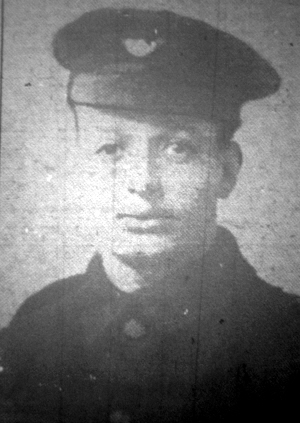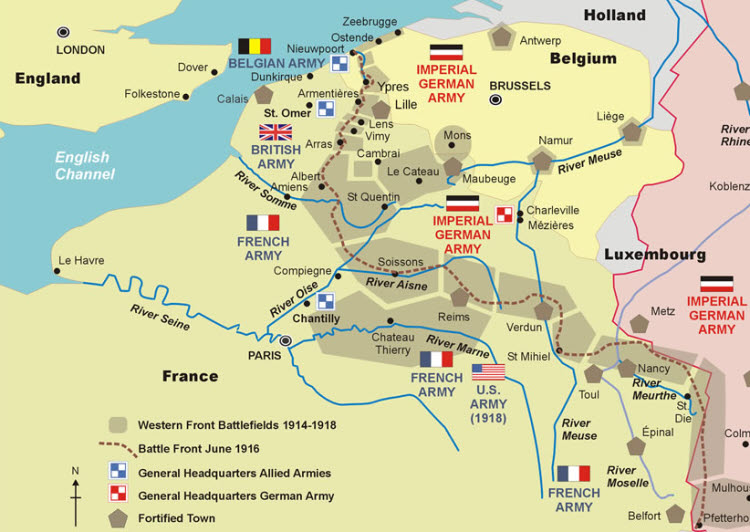
William Binns was born in 1891 in Wakefield, the son of Charles Henry Binns and his wife Lily (nee Jacques) who had married in 1889. In 1901, the Binns family were living at Bishopsgate in Wakefield, where Charles worked as a labourer in a bottling store.
The Territorial 1st/4th Battalion of K.O.Y.L.I. was formed in August 1914 at Wakefield as part of the 3rd West Riding Brigade, West Riding Division. They moved upon mobilisation to Doncaster then in November 1914 to Gainsborough an then to York in February 1915. On the 12th of April 1915, they landed at Boulogne and on the 15th of May 1915, the formation became 148th Brigade, 49th (West Riding) Division.
Private William Binns was wounded and gassed on the 22nd July 1917 in action near Nieuport (now Nieuwpoort) in Flanders, on the Belgian coast. The area was heavily defended by the Germans and the 1st/4th Battalion of K.O.Y.L.I. suffered heavy casualties on the 22nd July by the first use by the Germans of two different types of gas: “Yellow Cross,” (Dichloroethylsulphide) known more commonly as “mustard gas.” and “Blue Cross,” (Diphenylchloroarsine), a type of ‘asphyxiant’ gas. After being taken to hospital, Private Binns died on the 28th of July 1917, aged 26 years. he was one of two Ossett Binns brothers to lose their lives during WW1.
The “Ossett Observer”, 1 had this report of William Binns’ death:
“The sad news was received on Wednesday morning that a well-known Ossett Territorial, Lance-Corporal William Binns (26), of the King’s Own Yorkshire Light Infantry, second son of Mr. and Mrs. Charles Henry Binns of Dearden-street, Ossett, had died from wounds and gas poisoning, received on the battlefield on the 22nd ult. Earlier in the week an official intimation had been received, stating that he was in hospital.
Lance-Corporal Binns had been a member of the Ossett Territorials since 1909. He was one of the men who were in camp with the battalion at Whitby when the Territorials were mobilised for active service at the outbreak of the war. In April 1915, he went to the front, and his term of service with the Territorials expiring thirteen months later, he claimed his discharge and returned home. A few months later, however, he was called up again under the Military Service Act, and returned to the front in January of the present year. Before the war deceased was employed at Messrs. Jessop Brothers Ltd., Ossett Spa. He was for a time associated with the Wesley-street, Wesleyan Sunday School.
The deceased has three brothers serving in the army. His elder brother Private Arthur Henry Binns (28), of the West Yorkshire Regiment, after having served in France, has been a patient at Netley hospital for eight months, but last week returned to his regiment for further training. Sapper Charles Edgar Binns (23), another brother, who prior to enlisting worked for Mr. A. Fawcett, plumber, is in the Royal Engineers, and has been in France for the last six months. The other brother, Air-mechanic Harold Binns (19) of the Royal Flying Corps, formerly employed by Messrs. A. Shaw and Son, Paleside, Ossett, has been in France about a couple of months.”
The 49th (West Riding) Division, which the 1/4th, KOYLI was attached had, following the Battle of the Somme, moved to the Neuve Chapelle area; the division stayed in this sector until 13 July 1917 when it was ordered to proceed to Bethune railway station. After de-training at Dunkirk, the division moved up the coast, taking over the coastal defences at Nieuport on 18 July.
The 1/5th KOYLI took over part of the front line with the 1/4th KOYLI in support of them. The KOYLIs soon discovered that this was not a quiet sector. On 19 July the Germans launched an attack but were beaten off. German artillery heavily bombarded the British positions on 20 July and again on the night of the 21/22 July, using a new type of gas shell. This gas, called mustard gas, caused blistering both externally and internally and, because it was colourless and virtually odourless, gave little warning of its presence. The only sign of the gas was a faint smell of garlic or mustard which was to give the gas its name. Upon coming into contact with it, there would be a slight irritation of the nose and throat followed by sneezing and vomiting; eyes became inflamed and painful, leading to temporary blindness. Coughing continued in survivors for a week.
The immediate effect of the bombardment of 21/22 July in the 1/4th KOYLI was seven men killed and nine men wounded. However this does not include those who had become poisoned by gas; nine officers and 413 men had been affected. The following day, there were a further three officers and 73 men who became affected by the lingering gas. (Casualties in the 1/5th KOYLI, although bad, were not as high as the 1/4th KOYLIs.)
With casualties as heavy as these the 1/4th KOYLI were withdrawn. However the full results of the gas attack only became apparent over the next few days. One man died of gas poisoning on 22 July and two on the next day. Over the course of the next five days, 82 men died of the effects of the gas; the rate at which the men died then began to diminish, with 20 men succumbing over the subsequent four days.

Above: Map of Western Front battlefields 1914-1918. Private William Binns was wounded and killed whilst serving at Nieuwpoort on the Belgian coast, south-west of Ostend.
Private William Binns is buried at the Coxyde Military Cemetery 2, West-Vlaanderen, Belgium at grave reference III L. 8. Coxyde Military Cemetery is located approximately 500 metres beyond the village of Koksijde on the N396 towards De Panne.
In June 1917, Commonwealth forces relieved French forces on 6 kilometres of front line from the sea to a point south of Nieuport (now Nieuwpoort), and held this sector for six months. Coxyde (now Koksijde) was about 10 kilometres behind the front line. The village was used for rest billets and was occasionally shelled, but the cemetery, which had been started by French troops, was found to be reasonably safe. It became the most important of the Commonwealth cemeteries on the Belgian coast and was used at night for the burial of the dead brought back from the front line.
The cemetery now contains 1,507 Commonwealth burials of the First World War, the French graves from this period having since been removed.
William Binns’ younger brother Sapper Charles Binns, also lost his life on the 3rd November 1918 from injuries received during WW1.
The eldest brother, Arthur Henry Binns, who served in the West Yorkshire Regiment after enlisting in February 1916, was discharged in 1918 after being in a Red Cross Hospital for ten months suffering from neuritis.
The youngest brother, Harold Binns, enlisted in March 1917 and serverd as a mechanic with the Royal Air Service in France and survived WW1.
References:
1. “Ossett Observer”, 5th August 1917